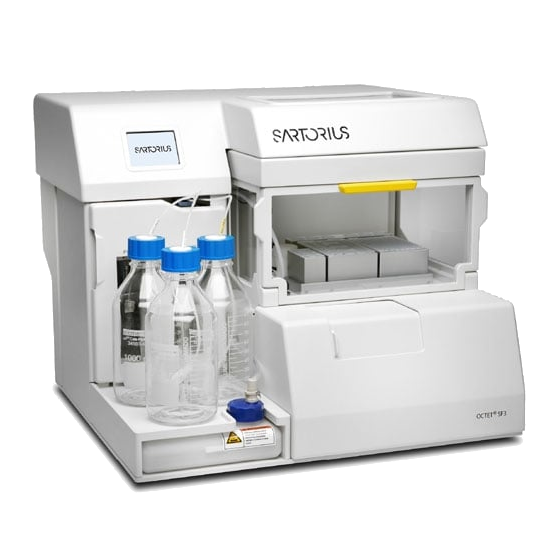News
🇪🇺 1𝘀𝘁 𝗖𝗮𝗹𝗹 𝗳𝗼𝗿 𝗧𝗿𝗮𝗻𝘀𝗻𝗮𝘁𝗶𝗼𝗻𝗮𝗹 𝗔𝗰𝗰𝗲𝘀𝘀 𝘁𝗼 𝗖𝗡𝗥 𝗢𝗽𝗲𝗿𝗮𝘁𝗶𝘃𝗲 𝗨𝗻𝗶𝘁𝘀 𝗶𝘀 𝗻𝗼𝘄 𝗼𝗽𝗲𝗻! 🇮🇹
𝗖𝗡𝗥-𝗜𝗖 𝗕𝗮𝗿𝗶 – 𝗖𝗡𝗥-𝗜𝗖 𝗨𝗥𝗧 𝗖𝗮𝘀𝗲𝗿𝘁𝗮 – 𝗖𝗡𝗥-𝗜𝗖𝗕 𝗖𝗮𝘁𝗮𝗻𝗶𝗮 – 𝗖𝗡𝗥-𝗜𝗕𝗣𝗠 𝗥𝗼𝗺𝗲
The nationally distributed 𝗜𝗧𝗔𝗖𝗔.𝗦𝗕 𝗥𝗲𝘀𝗲𝗮𝗿𝗰𝗵 𝗜𝗻𝗳𝗿𝗮𝘀𝘁𝗿𝘂𝗰𝘁𝘂𝗿𝗲, funded by 𝘕𝘦𝘹𝘵𝘎𝘦𝘯𝘦𝘳𝘢𝘵𝘪𝘰𝘯𝘌𝘜, is committed to supporting researchers👩🔬👨🔬by providing free access to cutting-edge technologies and expertise in the field of structural biology, including protein production, biophysics, mass spectrometry, crystal optimization, high-throughput screening, BioSAXS, NMR, cryo-EM, and high-performance computing.
The primary goal of this effort is to serve as a catalyst, helping researchers meet the high-quality standards required to access pan-European large-scale Research Infrastructures (e.g., Instruct-ERIC, Human Technopole) and advance their scientific endeavours.
➡️ 𝗩𝗶𝗲𝘄 𝘁𝗵𝗲 𝗹𝗶𝘀𝘁 𝗼𝗳 𝘀𝗲𝗿𝘃𝗶𝗰𝗲𝘀 𝗮𝘃𝗮𝗶𝗹𝗮𝗯𝗹𝗲 𝗮𝘁 𝗖𝗡𝗥 𝗢𝗽𝗲𝗿𝗮𝘁𝗶𝘃𝗲 𝗨𝗻𝗶𝘁𝘀 𝗮𝗻𝗱 𝘀𝘂𝗯𝗺𝗶𝘁 𝘆𝗼𝘂𝗿 𝗽𝗿𝗼𝗽𝗼𝘀𝗮𝗹 𝗶𝗻 𝗷𝘂𝘀𝘁 𝗼𝗻𝗲 𝘀𝗶𝗺𝗽𝗹𝗲 𝘀𝘁𝗲𝗽: click here
Applications will be assessed based on technical feasibility and prospective scientific quality. Within the framework of this call, access to the instrumentation for accepted proposals is covered💰; however, travel and accommodation expenses are 𝗻𝗼𝘁 included.
—————
Exciting Opportunity for Italy-Based Researchers: Apply Now for the Instruct Access Call
Are you a researcher based at an Italian institution? Instruct Access Call offers you the opportunity to access Instruct facilities for your integrative structural biology research. Through this call, Instruct and ITACA.SB offer financial support to access a variety of Instruct facilities that provide diverse services to assist your research in
this field.
Key Details:
Eligibility: You must be based at an institution in Italy to apply.
Project Timeline: Accepted projects need to be finalised within 5 months of proposal acceptance, with samples ready for immediate access to Instruct facilities upon approval.
Call End: 19-Feb-2025 at 13:00 CET.
How to Apply: Click here Submit Application – Instruct-ERIC to begin your application. Your draft applications will be saved and can be continued at any point from your dashboard.
Don’t miss this unique opportunity to advance your research with Instruct’s facilities and support. Apply today!
—————
New CryoEM Data Analysis Cluster @ CNR-IC URT Caserta
A state-of-the-art cryoEM computing cluster has been installed at the Institute of Crystallography URT Caserta to support cryoEM data processing, both on-the-fly and asynchronous. The cluster consists of 4 compute nodes, for a total of 16 NVIDIA RTX A5000 GPUs and approximately 400 TB of data storage, providing robust computational resources for advanced cryoEM data analysis.
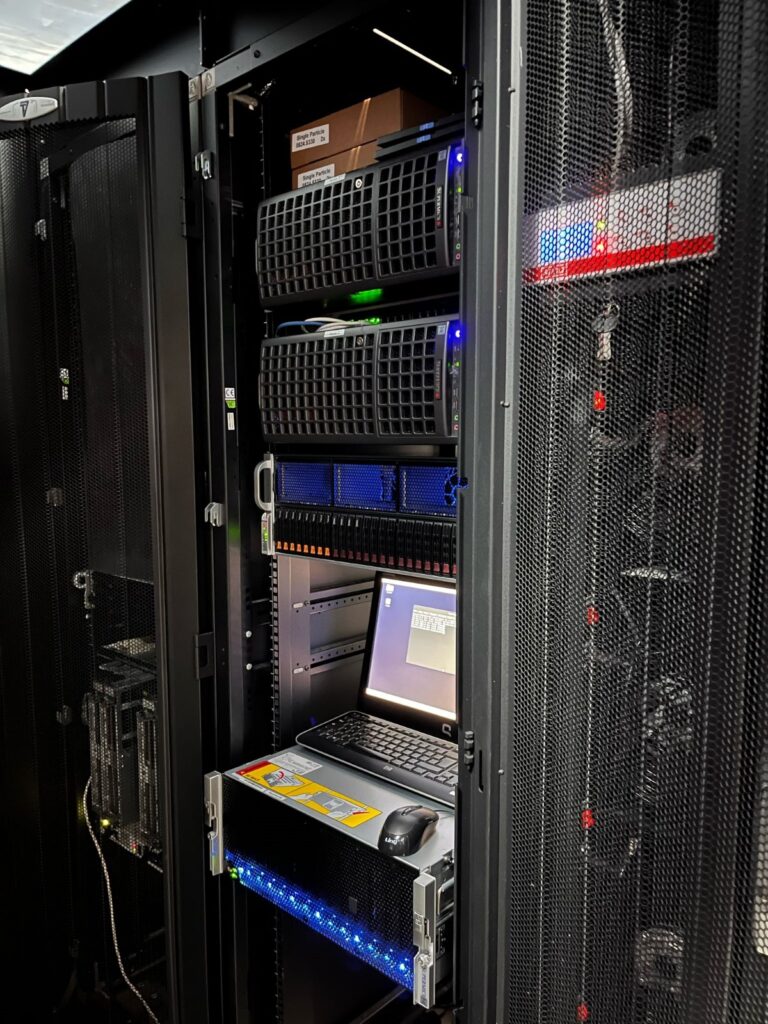
—————
New HPC Cluster: HERMES @ CNR-IC
The Institute of Crystallography hosts HERMES (High-performance Environment for Research in MolEcular and Structural Biology), a high-performance computing cluster designed to provide support to the scientific community for CryoEM, BioSAXS, X-Ray data storage and processing, as well as to enhance theoretical and computational research in Structural Biology and Drug Discovery. Specifically, the system consists of 5 CPU compute nodes and 4 CPU/GPU compute nodes, each with 4 NVIDIA H100 GPUs capable of delivering high computational power for applications such as image processing, artificial intelligence model training, and biological big data processing. Additionally, the system features a Scale-Out NAS storage system capable of supporting the storage of large amounts of data.
The system is being tested and configured. It is expected to enter production phase in early 2024.
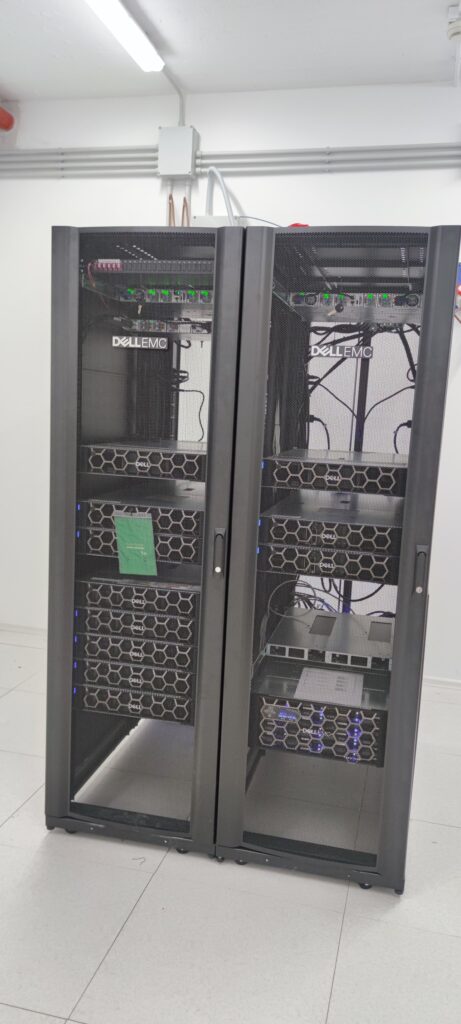
—————
ITACA.SB in Mexico Scientific Community
During his visit to UNAM (Universidad Nacional Autónoma de México) and CINVESTAV (El Centro de Investigación y de Estudios Avanzados), within the framework of the 2023-2024 CNR-CINVESTAV bilateral agreement, for which he is responsible on the Italian side, Dr. Siliqi (IC-CNR, Bari) presented the ITACA.SB project, outlining its facilities and future collaboration opportunities with the structural biology community in Mexico. The presentations took place on three occasions:
– At the Department of Chemistry at CINVESTAV, during the concluding event of the 2023-2024 Bilateral Project,
– At the Institute of Biochemistry at UNAM, during the “Teller BioSAXS” workshop,
– At the Faculty of Medicine at UNAM, during the seminar “BioSAXS: Dealing with Tough Flexible/Multidomain Protein Structures“, with the participation of Principal Investigators from various research groups.”
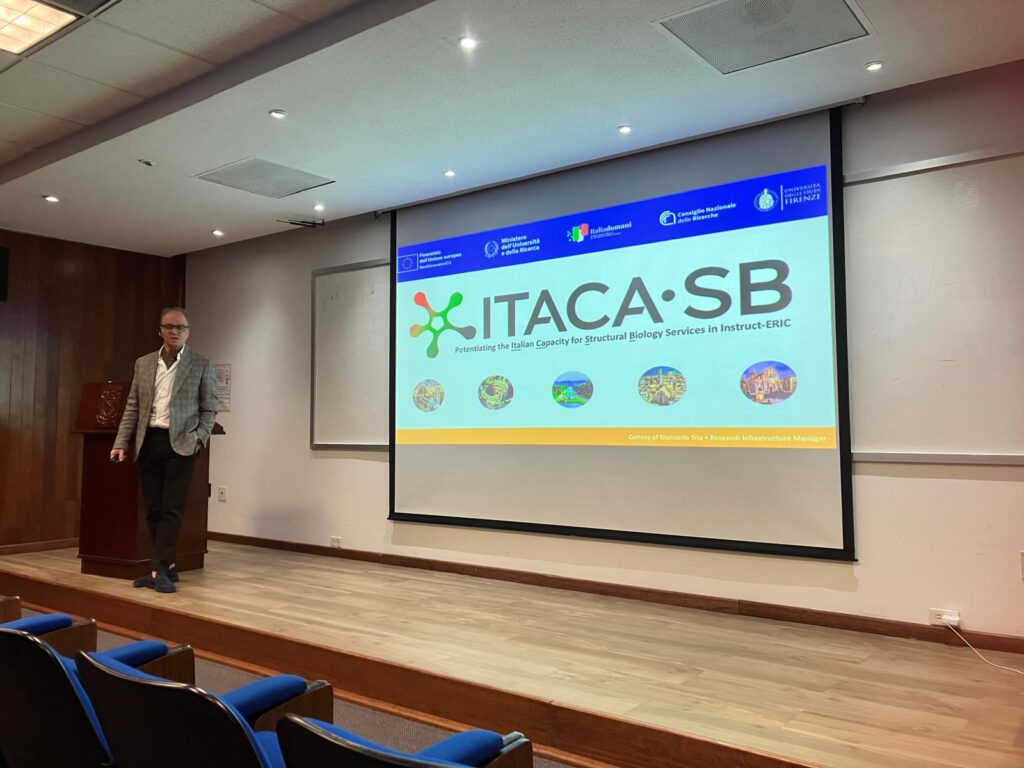
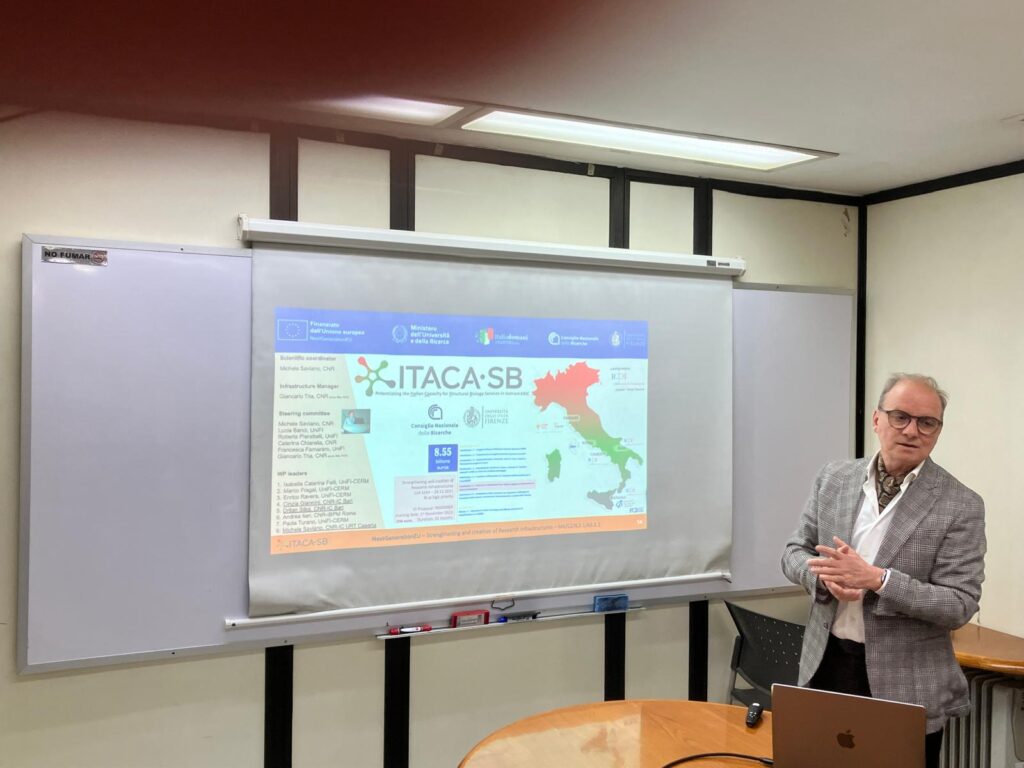
—————
ITACA.SB webinar series Fall-Winter 2024/2025
—————
New tests on 31P probe at CERM!
The 31P spectrum of a G-quadruplex RNA has been obtained using the
QCI-P cryoprobe in the 500 MHz instrument. The spectrum was obtained
with a good signal-to-noise ratio in a few minutes!
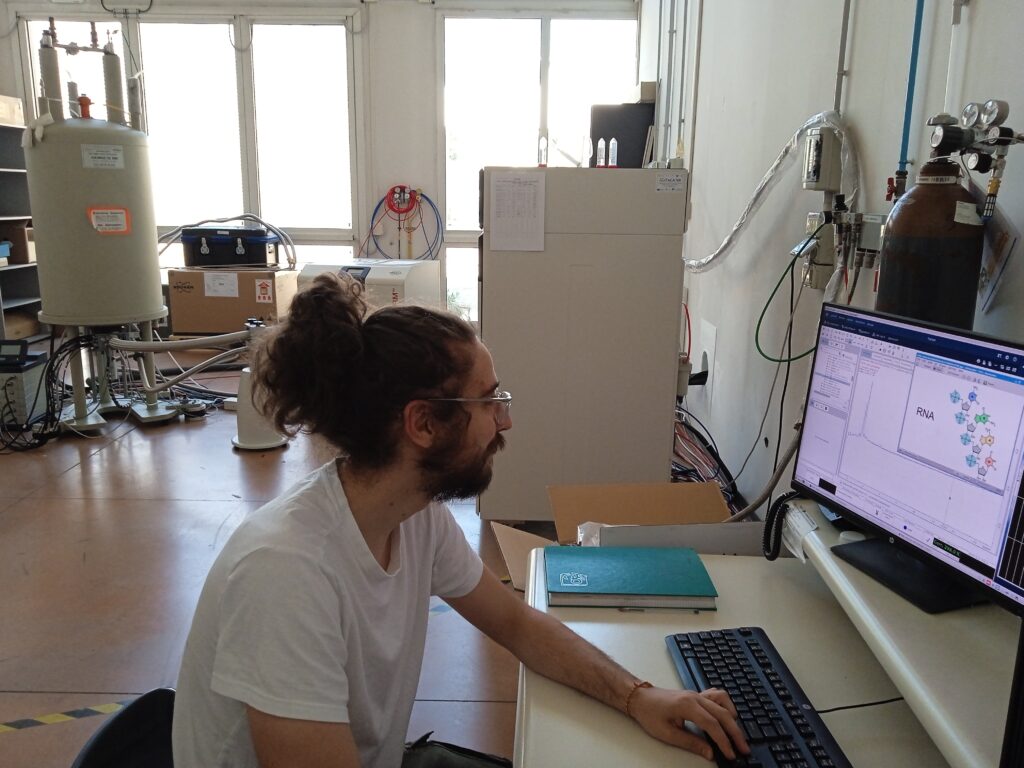
New BBO probe for diffusion experiments @ CERM!
New BBO probe and gradient system for performing diffusion experiments
(DOSY) has just been installed at CERM on the 700 MHz wide-bore
spectrometer! This set-up is unique and integrates high resolution,
high power and high field to label molecules in the NMR tube according
to their differential dynamics. It is the first probe in the world
with such characteristics for a 700 MHz instrument. The performances
have been tested on a beer sample and on a mixture of proteins. This
probe allows the analysis of the diffusion of molecules with a wide
range of molecular weights, from small ligands to huge protein
complexes. It will find useful applications in the analysis of
protein-protein complexes, as well as aggregates of different sizes.
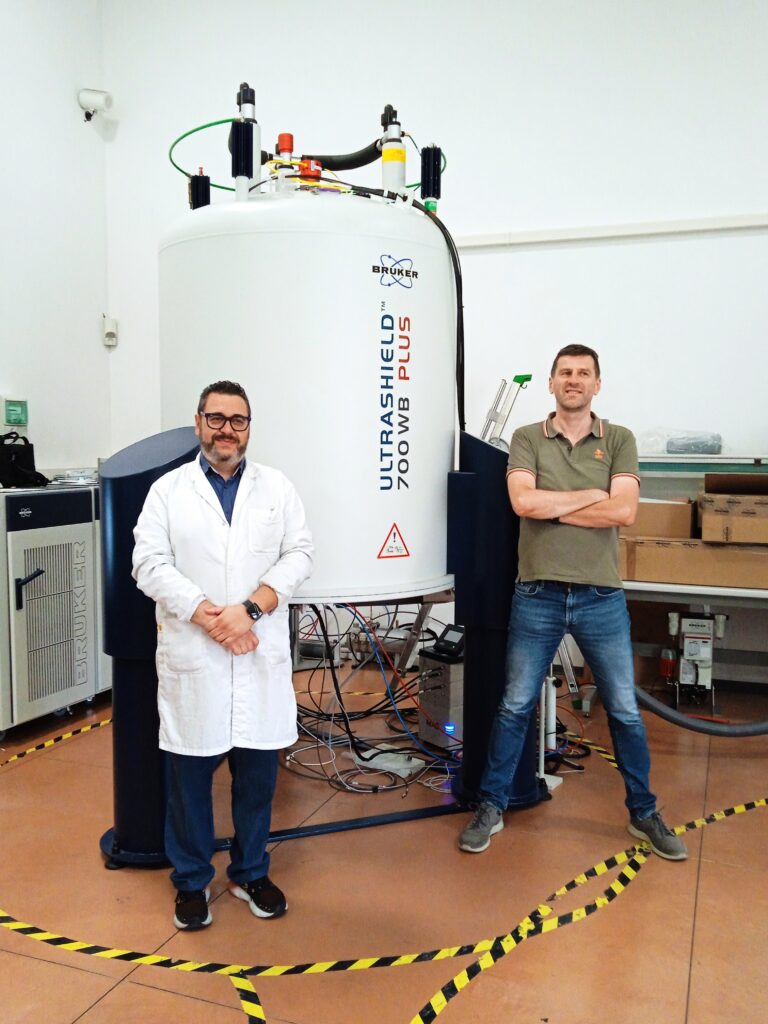
New Meeting @ CERM!
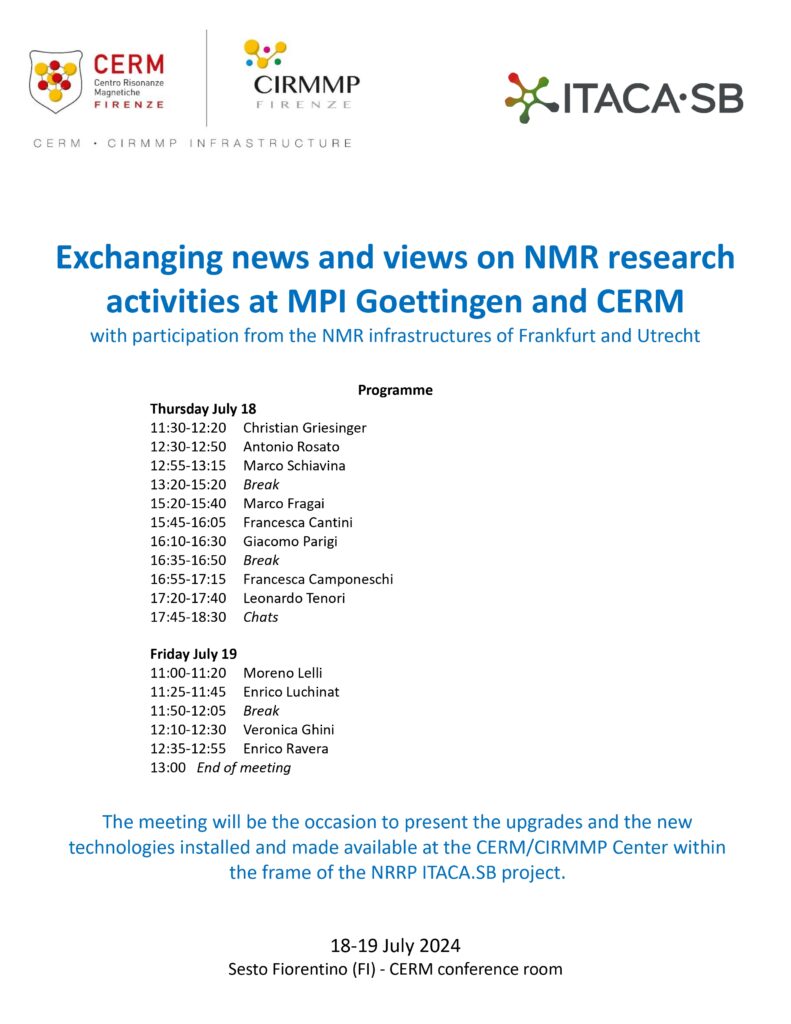
New Cryoprobe for 19F @ CERM!
The new cryoprobe for detecting 19F nuclei has just been installed at CERM in the new 600 MHz NMR spectrometer!!! It is a QCI-cryoprobe that allows the excitation of 4 different nuclear spins, including 1H, 19F, 13C and 15N. This probe will enable the implementation of state-of-the-art NMR experiments to monitor 19F present in modified amino-acids, included in a protein sequence, as well as in many ligands. It will also find useful applications for in-cell NMR by monitoring 19F signals of ligands upon binding to protein in the cellular environment, with the possibility to collect at the same time the protein 2D 1H-15N HSQC spectrum to access the protein binding surface in a protein-based approach.
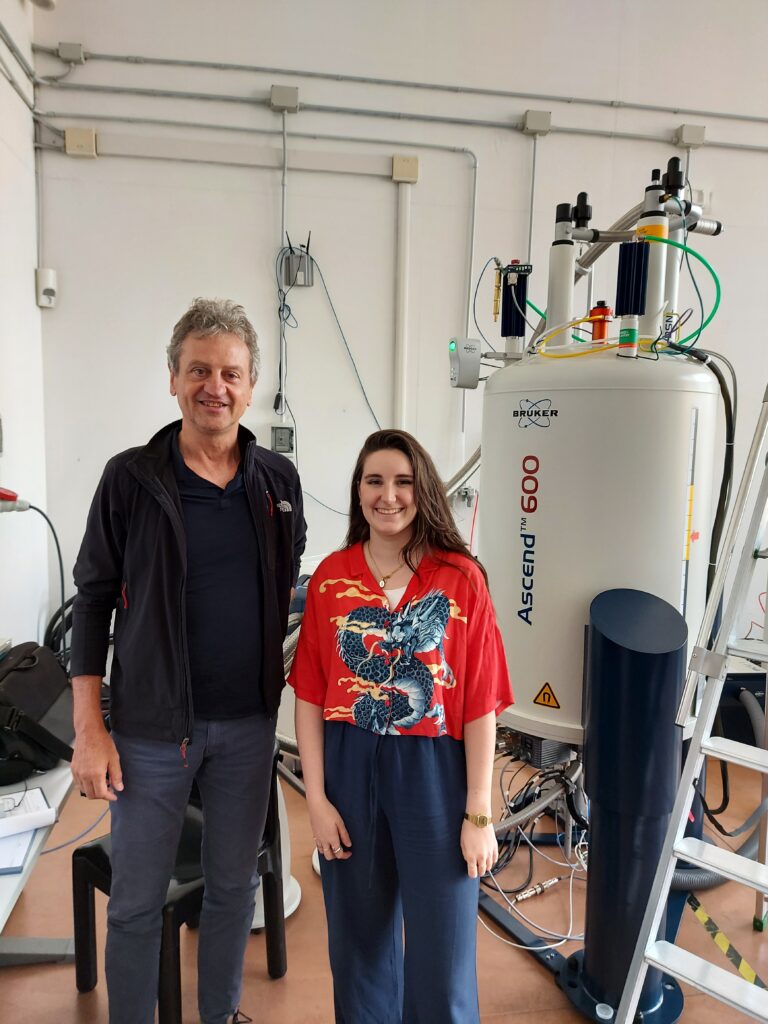
New 2 Microscopes @ CNR-IBPM!
Two Zeiss SteREO Discovery V20 KMAT stereomicroscopes offering magnification up to 96.5x and 150x. LED light sources provide clear field, dark field, and oblique illumination. The microscopes can be used with polarization lenses to identify crystals by birefringence. One microscope has a color Axiocam208 camera (4K resolution, 30 fps, 8.3 megapixels) for capturing images and videos
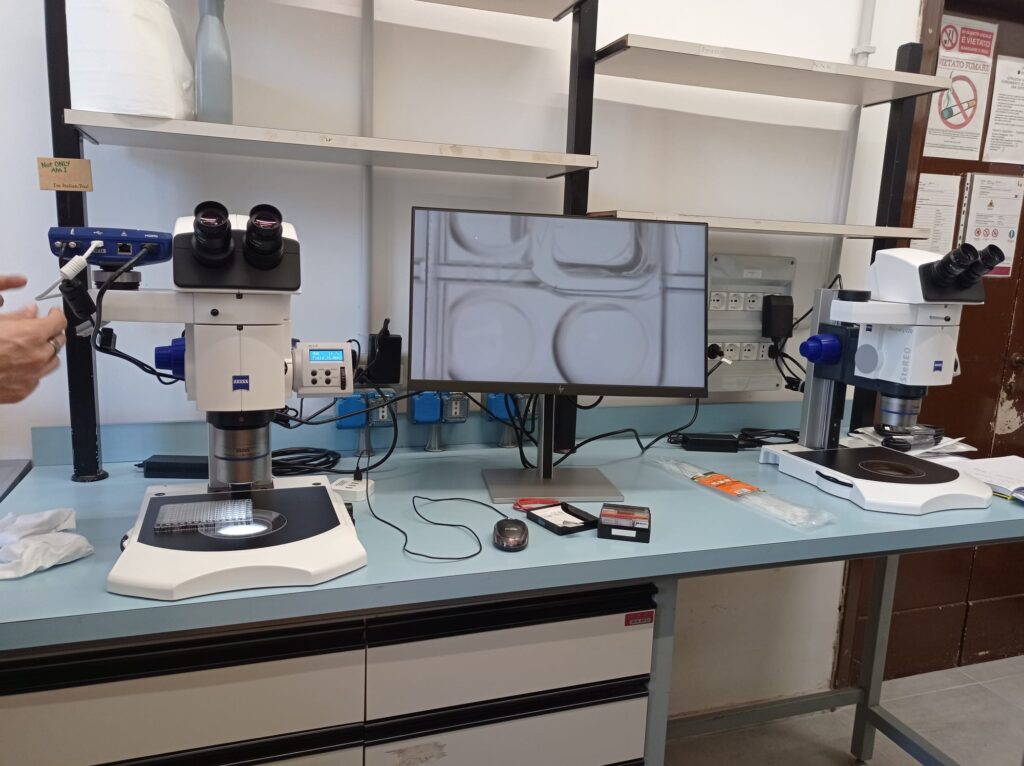
New Liquid Handler @ CNR-IBPM!
Eppendorf epmotion 96 liquid handler for fast and precise semi-automated pipetting in a 96-weel format. Acquired to Implement the crystallization platform at our facility in Rome (CNR-IBPM)
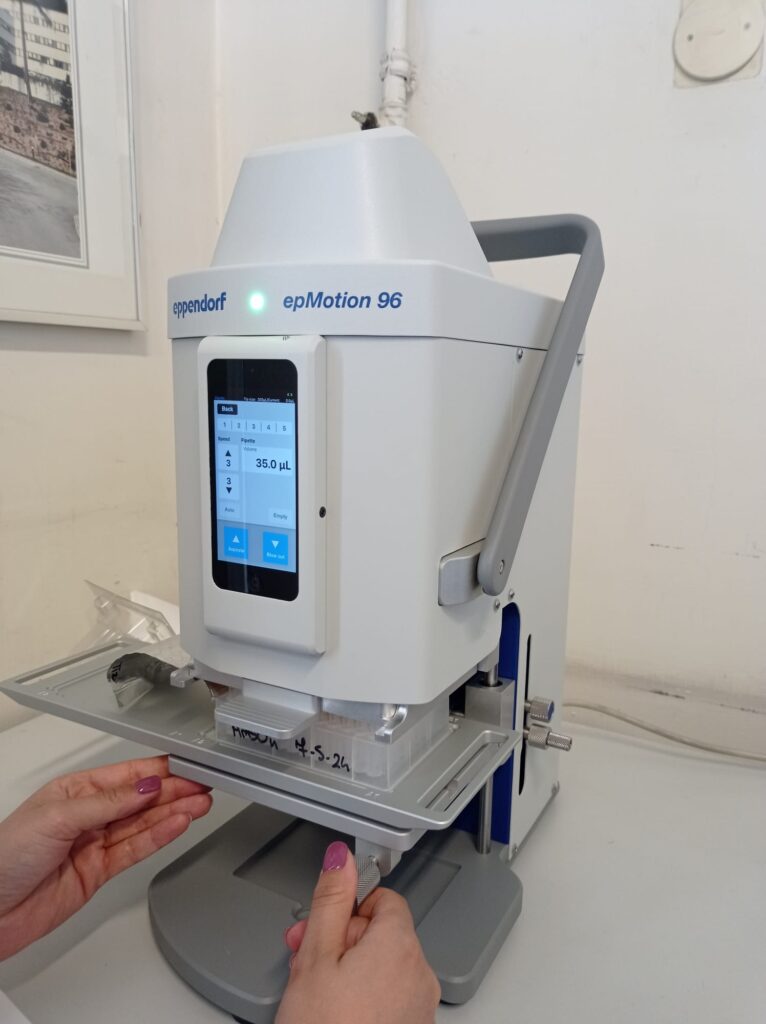
New NEO console at the 700 MHz WB NMR Instrument!
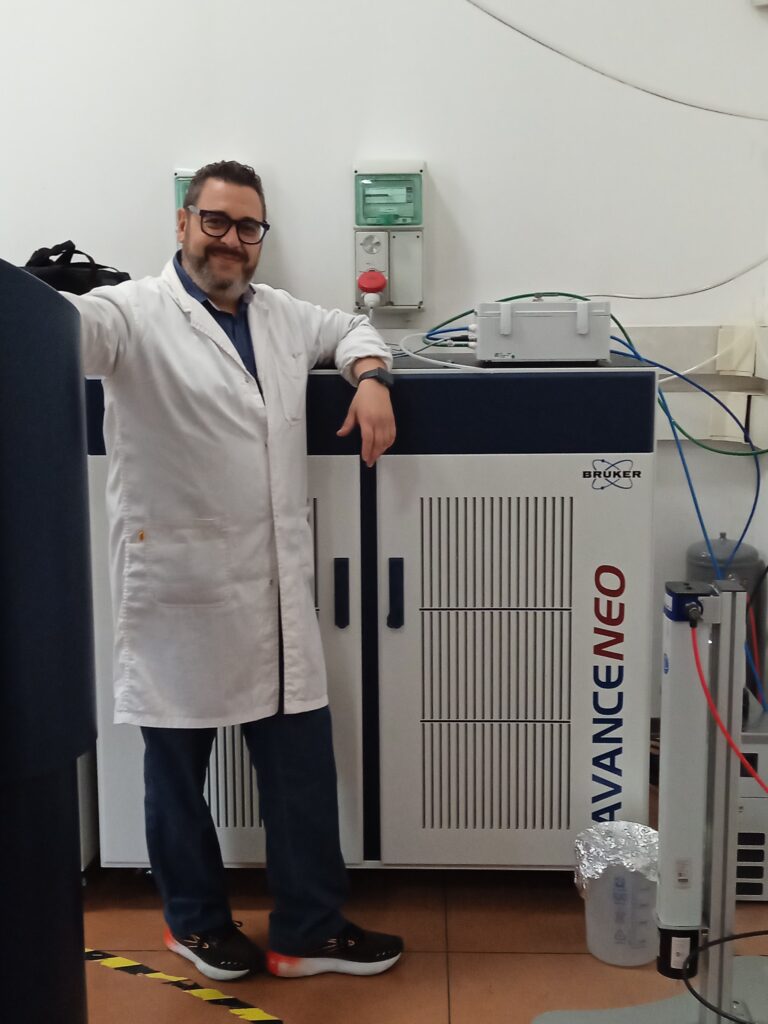
New Crystallization Robot Oryx 8 @ CNR-IBPM!
The Oryx 8 Crystallization Robot is a product of Douglas Instruments and is designed for protein crystallization. It is capable of setting up sitting drops with volumes ranging from 100 + 100 nl to 2 + 2 µl for 96 wells. For hanging drop experiments, up to five drops can be set up per cover slide, with volumes up to 8 + 8 µl. The Oryx 8 uses multi-bore dispensing tips (microtips), which have several independent channels to dispense small volumes. Each channel dispenses a different solution, and the solutions mix in the drop after they are dispensed. This system is ideal for microseeding experiments as the microtip always touches the plate when liquids are dispensed. Moreover, the Oryx 8 is equipped with two chassis and can use 3, 4, and 7-bore microtips. Large volumes, including oil for microbatch experiments, are dispensed by the right-hand arm using the large (2 ml) motorized syringe.The Oryx 8 is known for its versatility and minimal waste of protein solution, making it a preferred choice for protein crystallization.
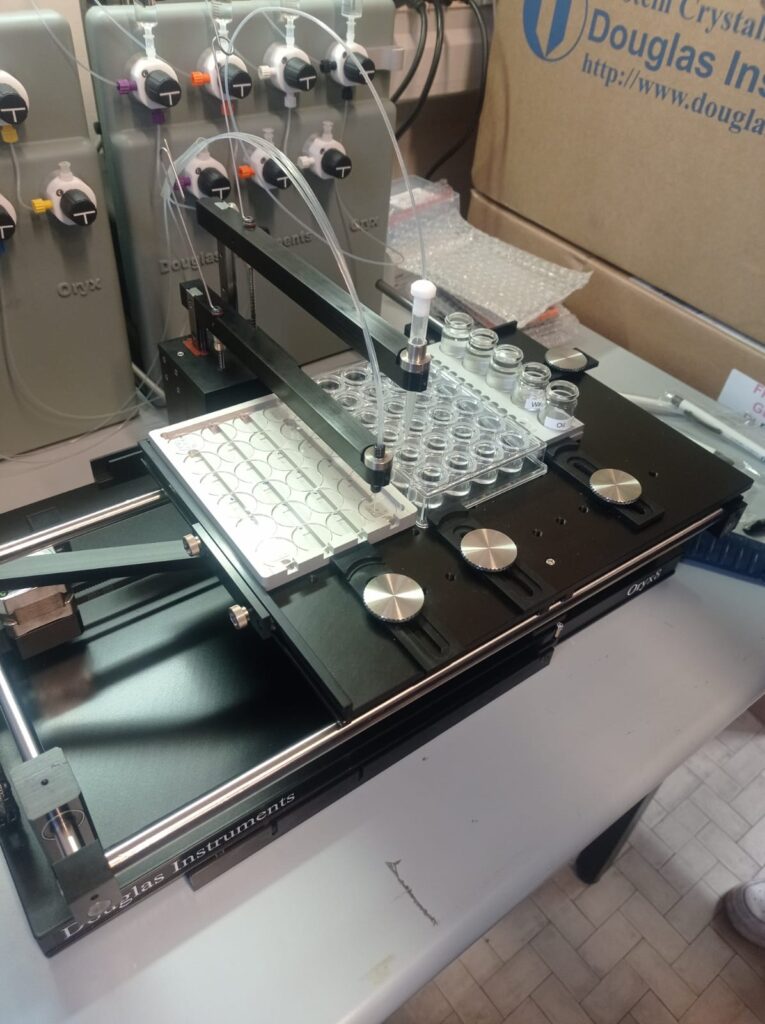
New Cryoprobe @ CERM!
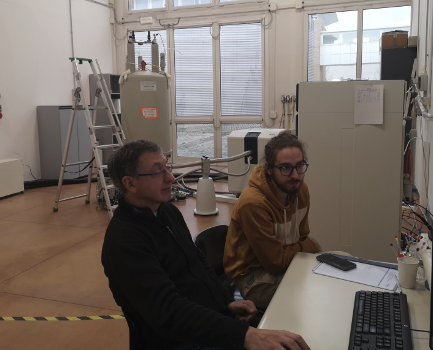
New Endor module @ CERM!
New Microscope @ CERM!
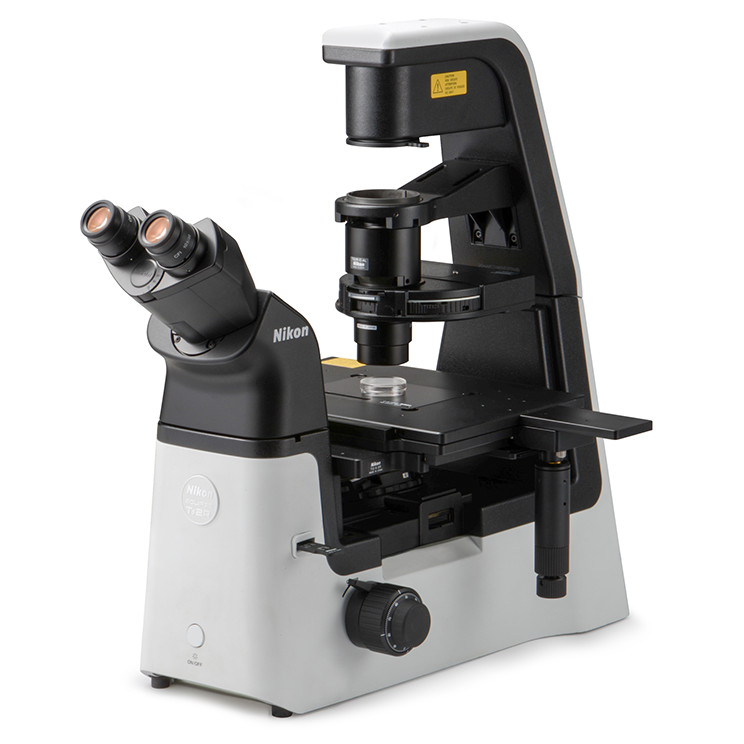
New Server Cluster @ CERM!
The purchased servers are intended for molecular dynamics calculations, for innovative AI projects applied to biological frameworks (mainly proteins).
Servers specifications:
Model: 8x Dell PowerEdge R750
CPU Intel Xeon Silver
256 GB RAM
2 x GPU Nvidia L40
These servers will be connected with a new 10 Gbps network to a new NAS with 100 TB of storage
New Cryo-EM @ CNR-IC!
Glacios by Thermo-Fisher Scientific Cryo-TEM features 200 kV XFEG optics, the industry-leading Autoloader (cryogenic sample manipulation robot), as well as the same innovative automation for ease of use as on the Krios G4 Cryo-TEM – all of them bundled into a small footprint that simplifies installation. The designed-in connectivity ensures a robust and contamination-free pathway throughout the entire workflow – from sample preparation and optimization, to image acquisition and data processing.
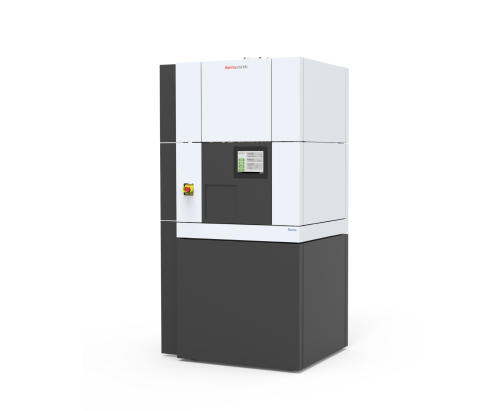
New Cytometer @ CERM!
Key features of the Guava® easyCyte™ Flow Cytometer include:
Microcapillary Fluidics Design: This innovative design eliminates sheath fluid and reduces waste.
Direct Absolute Counting: The microcapillary technology and a positive displacement syringe pump provide industry-leading precision.
High Degree of Flexibility: The system offers up to 3 lasers and 14 parameters on a benchtop instrument.
System Upgradability: The system is future-proofed.
Intuitive Software Interface: This feature simplifies the assessment of results.
Broad Variety of Samples: The system has detection limits of 0.2 to 60 µm, allowing for the evaluation of a broad variety of samples.
High-Throughput Options: The system offers single sample and high-throughput options for walkaway acquisition.
The Guava® easyCyte™ Flow Cytometer can provide single, dual, or triple excitation laser configurations, providing up to 14 simultaneous detection parameters, including 12 fluorescent colors plus forward and side scatter for size and granularity determination. It’s powerful enough to run your most complex assays. The system is also user-friendly, with a self-aligning flow cell that can be removed for cleaning by the user.
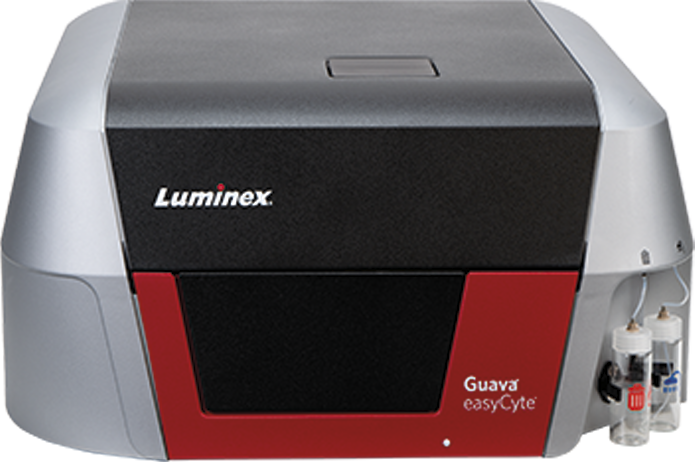
New PhD students enrolled @ CERM!
At CERM , four new doctoral students have started their journey. Welcome to Jlenia Bindi, Martina Masini, Bianca Susini and Cosimo Ciofalo!
New ITC @ CERM
The laboratory is equipped with a cutting edge microcalorimetry instrument (MicroCal PEAQ-iTC) which is a semi-automatic system capable of studying interactions between molecules in native conditions, without the need for molecular probes and immobilization of the sample. The thermodynamic parameters of a system can be measured in a single measurement using only 5 μg of a macromolecule in 280 μL volume. Furthermore, this instrument is capable of measuring KD between millimolar to nanomolar range, under standard measurements, and between nanomolar and picomolar when using competitive assays. The instrument can operate at different temperatures ranging 2 to 80 °C, with a thermal stability of +/- 0,00012 °C at 25 °C.
This system can remove bubbles from the samples and can accurately and precisely injected volumes of 0.1 μL to 40 μL of titrant. Consequently, this increases the experimental resolution. Furthermore, this system allows a throughput of 8-12 samples in eight hours. This instrument is also compatible with acid, bases and different solvents.
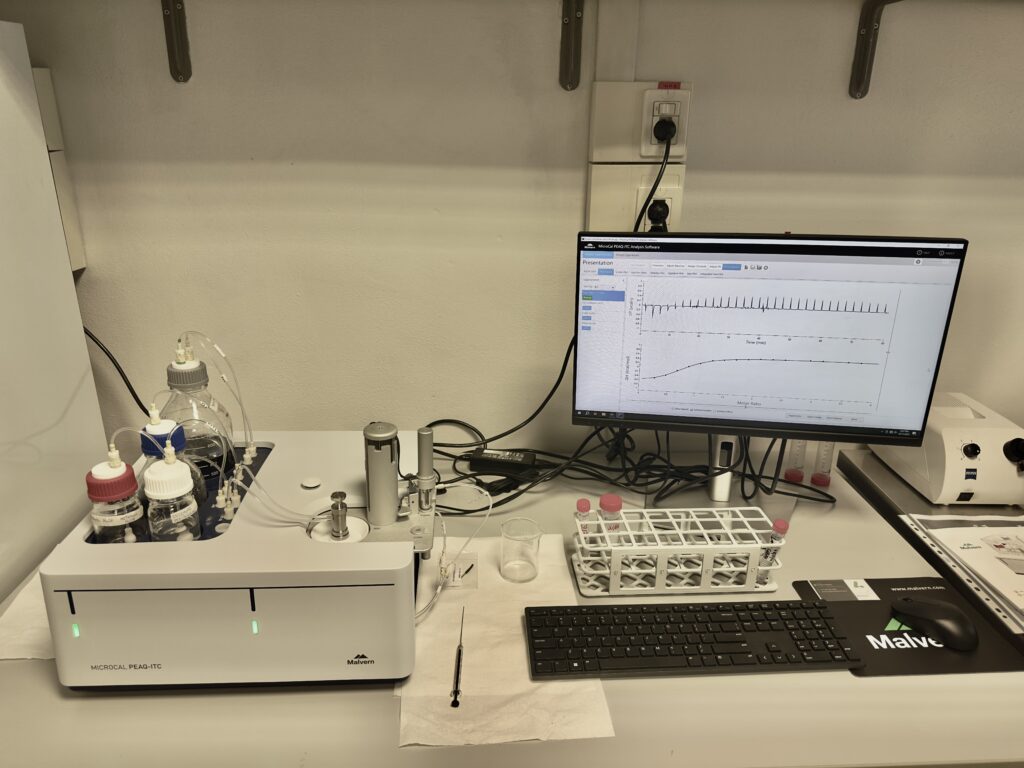
New Stopped-Flow @ CERM
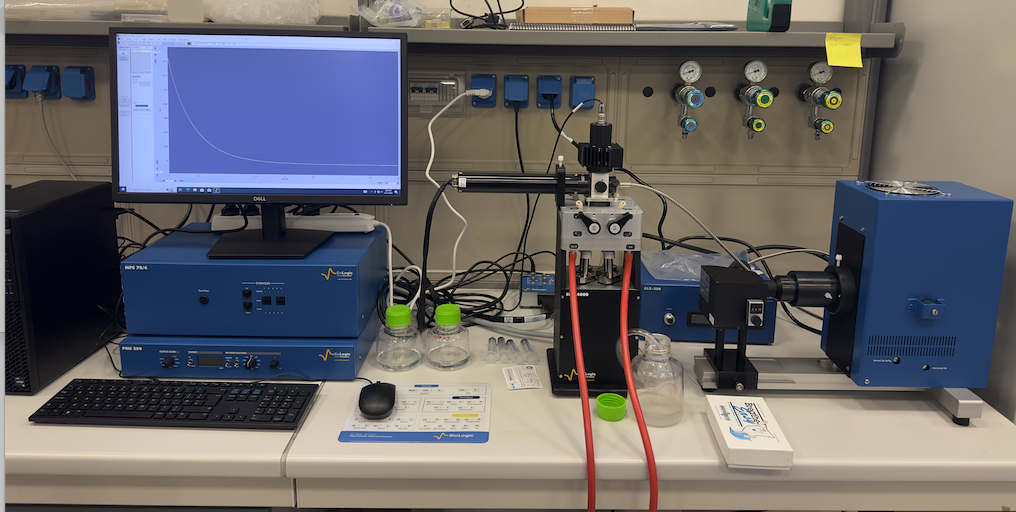
New SEC-MALS @ CERM
The laboratory is equipped with the latest generation Dawn 18 system and it will have the accessories Optilab, WyattQELS, Eclypse and HPLC 1260 Bioinert. The Dawn system includes 18 angles of scattering which can measure the molar mass with an error under 0.5 %, from a range of 200 Da to 100 MDa, and the size of the particle with an error under 3 %, from a range of 10 nm to 500 nm. Optilab accessory allows the real-time measurement of the macromolecular concentration using the refracting index with a differential refracting index (dRI) range between -0.0047 to +0.0047 and sensitivity: ± 7.5 x 10-10 and a Peltier temperature control between 4 to 65 °C. The WyattQELS is an integrated DLS accessory capable of measuring the hydrodynamic radius in the same scattering volume viewed by the MALS detectors, thus eliminating artifacts that can occur due to band broadening or temporal displacement between separate detectors. Eclipse accessory is an advanced field-flow fractionation (FFF) instrument that separates macromolecules and nanoparticles by size, ranging from 1 to 1000+ nm, using tunable flow rates. Furthermore, this instrument is compatible with many organic solvents such as THF and toluene. This instrument is also capable of switching between SEC and FFF modes, according to the desired requirements for sample separation and characterization. Lastly the HPLC 1260 Bioinert has an autosampler capable of performing highthroughput analysis of under pressure and within a temperature range of 4 to 40 °C.
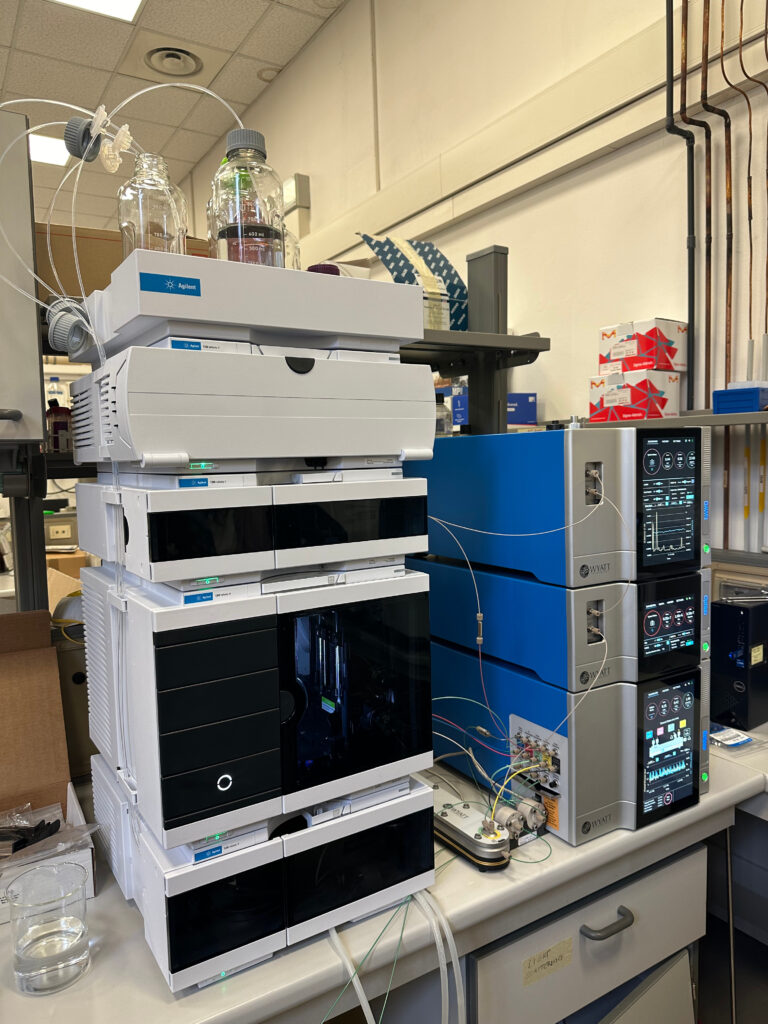
New Fluorimeter @ CERM
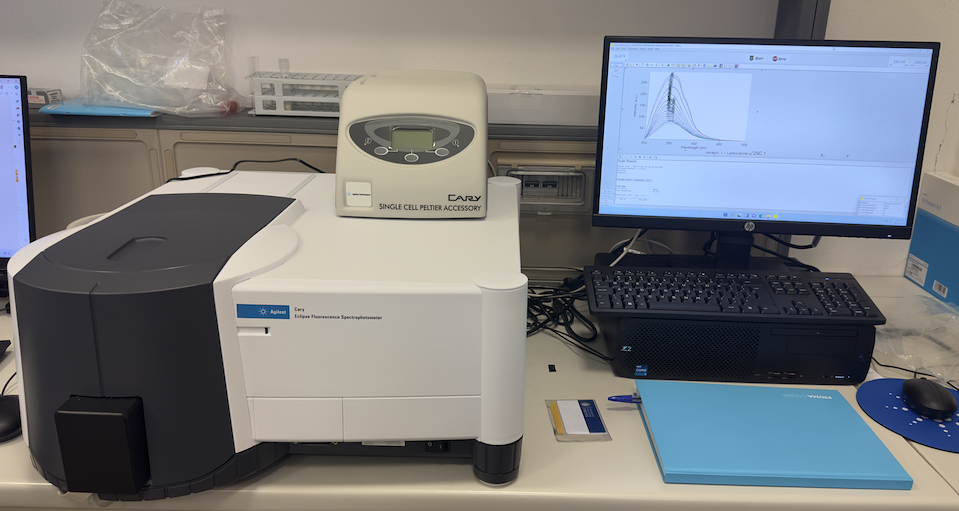
New SPR @ CNR-IBPM
The Octet® SF3 SPR System is a next-generation Surface Plasmon Resonance (SPR) instrument designed for high-throughput, low maintenance characterization of a wide variety of biomolecular interactions.
Key features of the Octet® SF3 include:
OneStep® Injection Technology: This technology eliminates the need to prepare multiple dilution series by using a single analyte solution to create a comprehensive concentration gradient for kinetics and affinity analysis.
NeXtStep™ Gradient Injections: This feature allows for the determination of an analyte’s full kinetics and affinity in the presence of multiple competitors from a single analyte concentration.
High-Throughput Sample Acquisition: The Octet® SF3 can generate complete binding kinetics and affinity for up to 768 samples in a single unattended assay.
Software designed by users for users: The Octet® SF3 offers a robust, high-throughput, low maintenance SPR solution for the rapid characterization of a wide variety of biomolecular interactions.
The Octet® SF3 is designed to help keep pace with the global demand for antibody fragment characterization, vaccine research, and whole cell biologics. It offers exceptional sensitivity for both small and large molecules, low baseline noise and drift, and large injection volumes. The system is also equipped with state-of-the-art fluidics and optimized electronic designs to minimize instrument downtime and ensure the generation of reliable, high-quality data.
